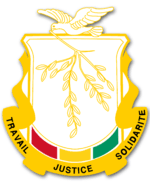National Assembly (Guinea)
| National Assembly Assemblée nationale | |
|---|---|
 | |
| Type | |
| Type | |
| Structure | |
| Seats | 114 |
Political groups |
Guinean People's Assembly: 53 seats Union of Democratic Forces of Guinea: 37 seats Union of Republican Forces: 10 seats Party of Hope for National Development : 2 seats Union for the Progress of Guinea : 2 seats Rally for the Integral Development of Guinea : 1 seat Guinea For All : 1 seat Union for Progress and Renewal : 1 seat Guinean Union for Democracy and Development : 1 seat Work and Solidarity Party : 1 seat New Generation for the Republic : 1 seat Guinean Party for Renaissance and Progress : 1 seat Guinea United for Development : 1 seat Generation for Reconciliation, Union and Prosperity : 1 seat National Party for Renewal : 1 seat |
| Elections | |
Last election | 28 September 2013 |
| Meeting place | |
| Conakry, Guinea | |
 |
| This article is part of a series on the politics and government of Guinea |
|
Constitution |
|
Government |
|
Parliament
|
The unicameral Assemblée nationale or National Assembly is Guinea's legislative body. Since the country's birth in 1958, it has experienced political turmoil, and elections have been called at irregular intervals, and only since 1995 have they been more than the meaningless approval of a one-party state's slate of candidates. The number of seats has also fluctuated. It is currently at 114, with members selected by two different methods.
Organisation
Two thirds of the members (76), called députés, are directly elected through a system of proportional representation, using national party-lists, while one third (38) are elected from single-member constituencies, using the simple majority (or first-past-the-post) system. Members must be over 25 years old and serve five-year terms.[1]
The President of the National Assembly of Guinea is the presiding officer of the legislature. Claude Kory Kondiano has been President of the National Assembly since January 2014.[2]
The Assembly is made up of 12 commissions:[1]
- Commission of accountancy and control
- Commission of delegations
- Economic, financial and planning commission
- Foreign Affairs Commission
- Commission for legislation, internal rules of the Assembly, the general administration and justice
- Commission of defense and security
- Commission of natural resources and sustainable development
- Commission of industries, mines, commerce and handcraft
- Commission of territorial arrangement
- Commission of civil service
- Commission of youth, arts, tourism and culture
- Commission of information and communication
Duties and responsibilities
The Assembly is responsible for ordinary laws and the government's budget.[1]
It ordinarily meets in two annual sessions, beginning 5 April and 5 October (or the next working day if a holiday) and lasting no more than 90 days. Special sessions can be called by either the President of Guinea or a majority of the Assembly members.[1]
Building
The National Assembly has its headquarters in the Palais du Peuple (People's Palace),[3] which was built with Chinese assistance.[4]
Elections
1963
Guinea was a one-party state, so the sole legal party, the Democratic Party of Guinea – African Democratic Rally, won all seats in the Assembly.[5]
1968
The Democratic Party of Guinea – African Democratic Rally once again secured all of the then-75 seats,[6] and Ahmed Sékou Touré retained the presidency.[7]
1974
With no other parties legally allowed, the Democratic Party of Guinea – African Democratic Rally took all now-150 seats, and Touré was reelected president unopposed.[8] Members were elected for seven-year terms.[8]
1980
The Democratic Party of Guinea – African Democratic Rally secured all now-210 seats as the only party, with Touré retaining the presidency.[9]
1995
The first election in which multiple parties were permitted was boycotted by one of the main opposition parties, the Union of Democratic Forces, but 846 candidates from 21 parties contested the 114 seats.[10] The Unity and Progress Party led the way with 71 seats, 41 proportionally and 30 by constituency, and its leader, General Lansana Conté, head of the country since a 1984 military coup d'état, became the second president.[10]
2002
The election was originally scheduled for April 2000, as the five-year terms of office expired, but was postponed four times for various reasons.[11] The 30 June 2002 election was won by President Conté's Unity and Progress Party, with 61.57% of the vote and 85 of the 114 seats.[11]
2013
Elections were held on 28 September 2013.[12] Alpha Condé's party, the Rally of the Guinean People, won the most seats, 53, but fell short of a majority.
See also
References
- 1 2 3 4 Ibrahima Sidibe. "Update: Guinean Legal System and Research". Hauser Global Law School Program, New York University School of Law.
- ↑ "Guinée: Claude Kory Kondiano, nouveau président du Parlement", Radio France Internationale, 13 January 2014 (French).
- ↑ Dying for Change: Brutality and Repression by Guinean Security Forces in Response to a Nationwide Strike. Human Rights Watch. 2007. p. 17.
- ↑ Shinn, David H.; Eisenman, Joshua (10 July 2012). China and Africa: A Century of Engagement. University of Pennsylvania Press. p. 286. ISBN 9780812208009.
- ↑ Nohlen, D.; Krennerich, M.; Thibaut, B. (1999). Elections in Africa: A data handbook. p. 454. ISBN 0198296452.
- ↑ "Date of Elections: January 1, 1968" (PDF). Inter-Parliamentary Union (PARLINE database of national parliaments).
- ↑ "14. Guinea (1958-present)". Dynamic Analysis of Dispute Management (DADM) Project, University of Central Arkansas.
- 1 2 "Date of Elections: December 27, 1974" (PDF). Inter-Parliamentary Union (PARLINE database of national parliaments).
- ↑ "Date of Elections: 27 January 1980" (PDF). Inter-Parliamentary Union (PARLINE database of national parliaments).
- 1 2 "Elections Held in 1995". Inter-Parliamentary Union (PARLINE database of national parliaments).
- 1 2 "Elections in 2002 election". Inter-Parliamentary Union (PARLINE database of national parliaments).
- ↑ Guinea's ruling party falls short of majority in legislative vote, Reuters, 19 October 2013, retrieved 26 October 2013
Coordinates: 9°31′12″N 13°41′32″W / 9.5200°N 13.6923°W